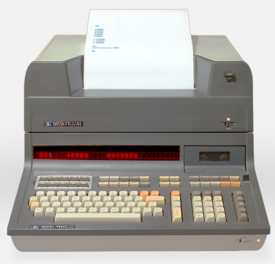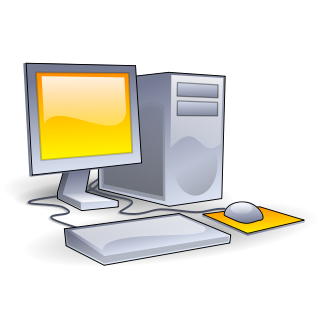- Desktop computer
-
A desktop computer is a personal computer (PC) in a form intended for regular use at a single location, as opposed to a mobile laptop or portable computer. Early desktop computers are designed to lay flat on the desk, while modern towers stand upright. Most modern desktop computers have separate screens and keyboards.
Prior to the widespread use of microprocessors, a computer that could fit on a desk was considered remarkably small. Early personal computers, like the IBM PC, were "desktop" machines, with a horizontally-oriented computer case, usually intended to have the display screen placed on top to save space on the desktop. In modern usage the word "desktop" usually refers to tower cases that are in fact more often located on the floor under the desk than on a desk.
Technically speaking desktop and tower computers are two different styles of computer case that use desk space in varying ways.[original research?] Cases intended for home theater PC systems are usually considered to be desktop cases in both senses, regardless of orientation and placement.[original research?]
Contents
History
 A sophisticated programmable calculator, the HP 9830A was actually an early desktop computer with printer.
A sophisticated programmable calculator, the HP 9830A was actually an early desktop computer with printer.
Early computers took the space of a room. Minicomputers generally fit into one or a few refrigerator sized racks. It was not until the 1970s when computers such as the HP 9800 series desktop computers were fully programmable computers that fit entirely on top of a desk. The first large calculators were introduced in 1971, leading to a model programmable in BASIC in 1972. They used a smaller version of a minicomputer design based on ROM memory and had small one-line LED alphanumeric displays. They could draw computer graphics with a plotter. The Wang 2200 of 1973 had a full-size cathode ray tube (CRT) and cassette tape storage. The IBM 5100 in 1975 had a small CRT display and could be programmed in BASIC and APL. These were generally expensive specialized computers sold for business or scientific uses. By the late 1970s and 1980s personal computers, such as the Apple II series and the IBM Personal Computer used standard processors to reduce cost to put a complete computer on top of a desk with a separate monitor. These would find uses in the home as well as in business and industry, and later incorporate graphic user interfaces and powerful networked operating systems such as Mac (Macintosh) and Windows.
All-in-one
All-in-One computers are desktop computers that combine the CPU and Speaker into the same case as the Monitor. Apple has manufactured several popular examples of all-in-one computers, such as the original Macintosh of the mid-1980s and the iMac of the late 1990s and 2000s. Some older 8-bit computers, such as the Commodore PET 2001 or Kaypro II, also fit into this category. All-in-One PCs are typically more portable than other desktop PCs and many have been built with carrying handles integrated into the case. They can simply be unplugged and transported to a new location.
Like laptops, All-in-One desktop computers are characterized by a comparative lack of upgradeability or hardware customization, as internal hardware is often placed in the back of the visual display unit. Furthermore, in the case of the iMac line since 2002, the CPU and other internal hardware units are, more or less, permanently glued to the motherboard due to space constraints.
However, latest models of the All-In-One Computer have changed their approach to this issue. Many of the current offerings are using standard off-the-shelf components and are designing upgrade convenience into their products.
Comparison with laptops
Desktops have the advantage over laptops that the spare parts and extensions tend to be standardized, resulting in lower prices and greater availability. For example, the form factor of the motherboard is standardized, like the ATX form factor. Desktops have several standardized expansion slots, like Conventional PCI or PCI express, while laptops only tend to have one mini PCI slot and one PC card slot (or ExpressCard slot). This means that a desktop can be customized and upgraded to a greater extent than laptops. Procedures for (dis-)assembly of desktops tend to be simple and standardized to a great extent too. This tends not to be the case for laptops, though adding or replacing some parts, like the optical drive, hard disk, and adding an extra memory module is often quite simple.
Another advantage of desktop is, that (apart from environmental concerns) power consumption is not as critical as in laptop computers because the desktop is powered from the wall socket. Desktop computers also provides more space for heat to escape. The two large microprocessor manufacturers Intel and AMD develop special CPUs for mobile computers (i.e. laptops) that consume less power and lower heat, but with lower performance levels.
On the other hand, laptop computers offer portability that desktop systems can not due to their small form factor. Laptops also more commonly integrate wireless technologies like WiFi, Bluetooth and 3G, giving them a broader range of options for connecting to the internet, though this trend is changing as more desktop computers come integrated with wireless.
Operating systems
An operating system is the program that after being initially loaded into the computer by a boot program, manages all the other programs in a computer.
Most of today's desktop computers have one of the three major operating systems available. In order of usage share, they are Microsoft Windows, Mac OS X, and Linux. Microsoft Windows and Linux can be used for almost any desktop computer, although Mac OS X can be used on some computers that are not Apple branded, the legality of this is currently disputed. Mac OS has been designed by Apple to only work on Apple computers unless you have an EFI emulator which creates an environment that can boot Mac OS X on a regular PC. New versions of each of these operating systems are released on a semi-regular basis. The newest version of Microsoft Windows is called Windows 7 and is widely regarded as a marked improvement over the previous Windows Vista.[1] The newest version of Mac OS is OS X Lion. Linux is available in multiple distributions, the more popular being Ubuntu, Fedora and openSUSE. Each distribution has its own version number and bundled software, but all distributions of Linux contain a Linux kernel.
Average selling price
For Microsoft Windows systems, the average selling price (ASP) showed a decline in 2008/2009, possibly due to low-cost Netbooks, drawing $569 at U.S. retail in August 2008. In 2009, ASP had further fallen to $533 by January.[2] All in one Mac desktops such as the 21.5 inch iMac start at $1,199. All in one PCs running Windows start at $399. The highest end gaming PCs can cost up to $10,000.
See also
References
- ^ Windows 7 review, retrieved 24th February, 2010.
- ^ Netbooks Are Destroying the Laptop Market and Microsoft Needs to Act Now, By: Joe Wilcox, 2009-04-16, eWEEK
External links
- HowStuffWorks Major components of a desktop computer
- Know the parts of your computer
- Learn even more about the parts of your computer
Computer sizes Larger Mini Micro Personal (Workstation · Desktop · Home · SFF (Nettop)) · Plug · Portable · Arcade system board · Video game consoleMobile Tablet computerTablet personal computer (Ultra-mobile PC) · Mobile Internet device (Internet tablet)Handheld PC (Palm-size PC · Pocket computer) · PDA (EDA) · Mobile phone (Feature phone · Smartphone) · PMP (DAP) · E-book reader · Handheld game consoleOthers Categories:- Personal computers
- Classes of computers
- Personal computing
Wikimedia Foundation. 2010.

